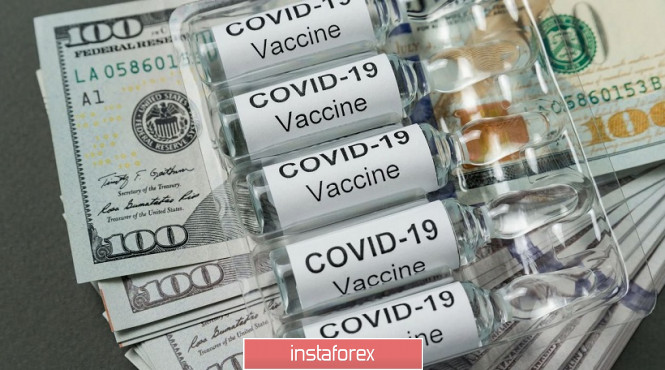The US dollar index opened a new trading week with a downward gap, which is relatively small, but very significant. If the index finished trading at 90.97 on Friday, then during the Asian session on Monday, it fluctuated around 90.70. In turn, the demand for the US dollar has declined due to several factors that reduced the overall interest in anti-risk assets, which include the US dollar.
Yesterday, it became known that the Brexit negotiations, which were supposed to end on December 13, will be extended for several more days. We should recall that the parties have already postponed the deadline several times, while the transition period ends in just two and a half weeks. Last week's face-to-face meeting between Johnson and Ursula von der Leyen ended unsuccessfully: politicians agreed only to continue negotiations, which were supposed to end last Sunday. However, both parties did not come to a compromise during the allotted time. Moreover, the worst-case scenario was not implemented: the negotiators did not put the final point in the negotiation process, saying that they need to "go another mile". Traders of the GBP/USD pair reacted strongly to this news. It opened today's trading with a significant upward gap (150 points). And although the future prospects are still quite vague, the very fact of prolongation of the negotiation process has increased the demand for risky assets. In turn, the US dollar stopped working again.

The coronavirus factor also failed to help the dollar. Even though the States recorded a daily growth in COVID-19 cases – 230 thousand last Friday, the previous anti-record (227 thousand) was recorded quite recently (early December). In total, almost 16 million infected and almost 300 thousand deaths from COVID-19 have been registered in the country since the beginning of the pandemic. In both indicators, the United States ranks first among other countries in the world.
In Autumn, USD benefitted from this crisis, as the growth of panic increased the demand for a safe dollar. But the situation has changed now: the market has literally and figuratively got vaccinated.
Earlier that season, the indicated currency steadily strengthened its position amid rapid growth in the number of COVID-19 cases in the US and around the world. After that, the press discussed the probability of repeated lockdowns and the possible economic consequences of such a step. The scenarios were "one worse than the other". Such prospects gave interest in defensive instruments, and above all in the dollar, which dominated almost all dollar pairs for several weeks.
It is also noteworthy that the market is quite logical (and even somewhat cynical) about the spread of coronavirus. Traders are primarily concerned about the reaction of the authorities and the possible economic consequences of the pandemic, while the growth in the number of infected is only secondary. At the moment, traders are considering the "coronavirus factor" through the spectrum of mass vaccination, which starts today in the United States. Pfizer has already delivered the drug to 145 vaccination centers, another 425 centers will receive the vaccine tomorrow and 66 on Wednesday. By the end of the week, the vaccine will be available in all centers that now have equipment for storing it at very low temperatures. Similar news is coming from other countries, in particular from the UK, where the vaccination process has already begun.
In other words, the "coronavirus factor" has lost its former influence. For example, the market actually ignored the coronavirus anti-record in the US last Friday, although such dynamics would have caused a surge in anti-risk sentiment even in the fall.
This week's focus is on the Fed and the US Congress. Members of the US regulator will hold their last meeting this year (December 15-16), while congressmen will continue negotiations on approving a new package of assistance to the economy. The approval of this package will determine the continued provision of unemployment assistance to more than 11 million Americans, as the current program will end on December 31.
In my opinion, Congressmen will still come to a compromise before this week ends, judging by the statements of the Speaker of the House of Representatives, Ms. Nancy Pelosi. She previously advocated the adoption of the $ 2 trillion package, disagreeing with the smaller amounts offered by the Republicans. However, it hypothetically supported a smaller package over the weeked, in light of Joe Biden's victory in the presidential election. According to her, a new, larger package of assistance will be agreed after the inauguration of the newly elected president.
Now, in case that American politicians still pass the long-suffering bill, the US dollar will be under pressure again, amid general optimism, growth in the stock market and Fed's dovish intentions/decisions to expand the existing stimulus programs.

If we talk directly about the EUR/USD pair, we can still consider longs here. This is also indicated by the technical picture. First, the pair is above all the Ichimoku indicator lines (including the Kumo cloud) on the D1 and W1 time frames. Second, the price on the weekly chart is located on the upper line of the Bollinger Bands trend indicator (it is between the middle and upper lines of this indicator on the daily chart). The first upward target is the level of 1.2177 (the two and a half year high reached the week before last). The main target is still the psychological important level of 1.2200, which also coincides with the upper Bollinger Bands line on the daily chart.
The material has been provided by InstaForex Company - www.instaforex.com